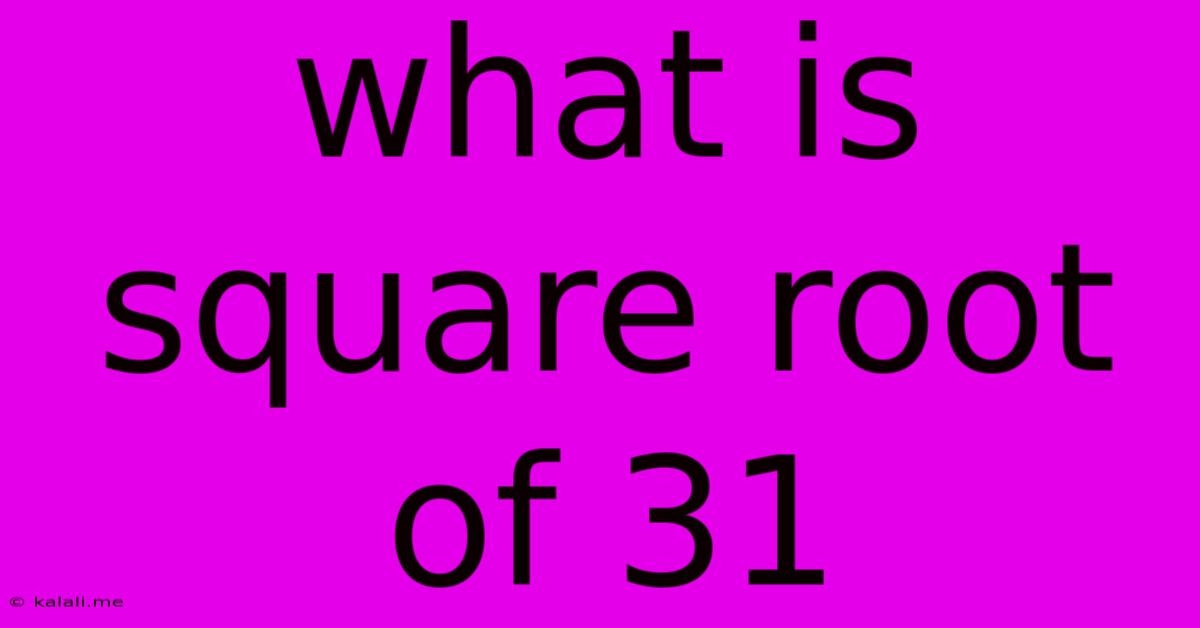What Is Square Root Of 31
Kalali
Jun 16, 2025 · 2 min read

Table of Contents
What is the Square Root of 31? A Deep Dive into Irrational Numbers
The square root of 31, denoted as √31, is a fascinating number in mathematics. It represents the number that, when multiplied by itself, equals 31. Unlike the square root of perfect squares like 9 (√9 = 3) or 16 (√16 = 4), √31 doesn't result in a whole number. This is because 31 is not a perfect square. This article will explore what √31 is, its approximate value, and its significance in mathematics.
Understanding Square Roots and Irrational Numbers
A square root is a number that, when multiplied by itself, produces a given number. For example, the square root of 9 (√9) is 3 because 3 x 3 = 9. However, not all numbers have whole number square roots. Numbers like 31, which are not perfect squares, have irrational square roots. Irrational numbers cannot be expressed as a simple fraction (a ratio of two integers). Their decimal representation continues infinitely without repeating.
Calculating the Approximate Value of √31
Since √31 is irrational, we can only approximate its value. Using a calculator, we find that:
√31 ≈ 5.56776436283
It's important to note that this is an approximation. The decimal representation goes on forever. For most practical purposes, however, rounding to a few decimal places (e.g., 5.57) provides sufficient accuracy.
Methods for Approximating √31 without a Calculator
While a calculator provides the easiest method, several techniques can approximate √31 without one:
-
Babylonian Method (or Heron's Method): This iterative method refines an initial guess to get closer to the actual square root. Start with an initial guess (e.g., 5) and repeatedly apply the formula: x_(n+1) = (x_n + (N/x_n))/2, where x_n is the current guess and N is the number (31 in this case). Each iteration will yield a more precise approximation.
-
Linear Approximation: This simpler method utilizes the fact that the function f(x) = √x is relatively smooth. You can find the tangent line to the graph of f(x) at a nearby perfect square (e.g., at x=25) and use that line to approximate f(31).
The Significance of Irrational Numbers
Irrational numbers like √31, despite not having a neat, finite representation, are crucial in mathematics and various scientific applications. They frequently appear in geometry (e.g., calculating diagonals of squares or lengths of hypotenuses in triangles), physics (e.g., calculations involving distances and velocities), and many other fields. Their infinite nature doesn't diminish their importance; rather, it highlights the richness and complexity of the number system.
In Conclusion
The square root of 31 is an irrational number approximately equal to 5.56776436283. Understanding its irrational nature and methods for approximating its value provides insights into the broader world of mathematics and highlights the significance of these numbers in various fields. While we can't express it exactly as a fraction, its approximate value serves its purpose in countless calculations.
Latest Posts
Latest Posts
-
Which Of The Following Is A Cloud Of Vertical Development
Jun 16, 2025
-
What Is The Relationship Between The Following Structures
Jun 16, 2025
-
Destructive And Non Destructive Testing Of Concrete
Jun 16, 2025
-
Requirements For Sam Houston State University
Jun 16, 2025
-
What Are The Five Colours Of The Olympic Rings
Jun 16, 2025
Related Post
Thank you for visiting our website which covers about What Is Square Root Of 31 . We hope the information provided has been useful to you. Feel free to contact us if you have any questions or need further assistance. See you next time and don't miss to bookmark.